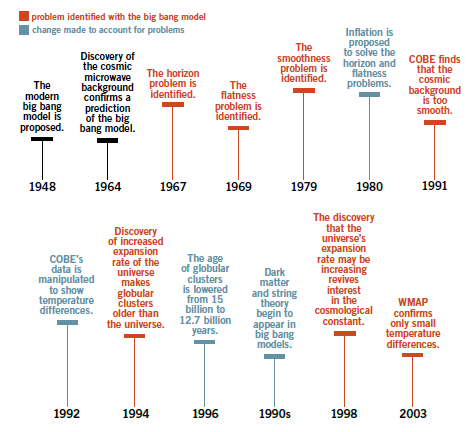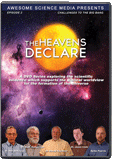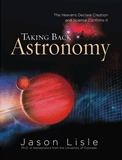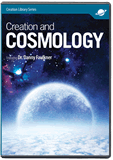Big Bang—The Evolution of a Theory
When it was first introduced, the “big bang” was sometimes an object of ridicule. But over the past decades, it has proven to be quite pliable, morphing to adapt to each new problem. Are these changes true improvements, or just rescuing devices?
We frequently hear in creationist circles that the big bang model is fraught with problems and is a theory in crisis. However, as Mark Twain reported about his death, its demise may be greatly exaggerated. But not for the reasons that you might think.
The big bang had little traction when it was first introduced, but a breakthrough came in 1964, when astronomers discovered the cosmic microwave background. The big bang model had predicted this microwave background, but the competing model (the “steady state” theory) had not. This background radiation supposedly comes from a period of time a few hundred thousand years after the big bang when the universe was still hot.
So the big bang quickly became the dominant theory of the history of the universe among cosmologists. Since then new observations and ideas have come along that have challenged the big bang. Rather than abandoning the theory, however, cosmologists and astronomers have met each challenge with modifications. In the process, the big bang has morphed into something that little resembles its first incarnation. Many people view these modifications as improvements, but are they really?
The Horizon Problem—Is Inflation the Answer?
Despite its supposed proof of the big bang, the cosmic microwave background has been a source of challenges to the standard cosmology. One difficulty is the horizon problem. No one expects that a big bang universe would have started with exactly the same temperature everywhere. If you look out into the universe in one direction, for example, due east, you will receive radiation from a distant region (call it region A) that secular astronomers say is just now reaching earth after traveling for more than 13 billion years, the supposed age of the universe. If you look in the opposite direction, for example, due west, you will see radiation that is just arriving from another location (call it region B). We find that the radiation from points A and B reveals that these regions have almost precisely the same temperature. But that shouldn’t be if the two regions haven’t yet had time to exchange energy and equalize their temperatures.
These points couldn’t yet have been in “thermal contact” with one another since they are 26 billion light years apart, so why do they have the same temperature? This question arises regardless of which direction we look.
About thirty years ago cosmologists attempted to resolve this problem with inflation. In cosmology, inflation is a hypothetical hyper-expansion (far greater than the speed of light) that occurred very early in the universe.1 This means the pre-inflation universe would have been incredibly small, and the entire universe could have been in thermal contact with itself. That would explain why the early universe reached the same temperature throughout.
Flatness Problem—Is Inflation the Answer?
Inflation also was invoked to explain another difficulty, the flatness problem. As the universe expands, the ratio of gravitational potential energy to kinetic energy (denoted by the Greek letter omega) changes. After billions of years of expansion, the ratio ought to be either almost exactly zero or a very large number. However, measurements have shown that the ratio is only slightly below 1. In the big bang cosmology this suggests that the value of omega initially was almost exactly 1, as opposed to an infinite number of other possibilities. This makes the universe seem very improbable.
So inflation is their rescuing device. If they assume inflation occurred in the early universe, it would have driven the value up to almost exactly 1, where it needed to be, and from that point it could have decreased only slightly, even after billions of years. There is no independent evidence that inflation indeed happened—outside of their need for it to happen. But astronomers almost universally accept that it did because otherwise they have no other way to solve the horizon and flatness problems.
Smoothness Problem—Solved by Revising the Theory?
Another problem with cosmic background radiation is that it is almost perfectly smooth. Today we see hierarchal structure in the universe, with matter clumped into stars that in turn are clumped into galaxies and clusters of galaxies. In short, the universe is clumpy, not smooth.
To explain this clumpy structure, cosmologists require that the matter in the early universe not be perfectly smooth (homogeneous) but instead have regions that were slightly denser, interspersed with regions that were less dense (an inhomogeneous universe). The denser regions supposedly acted as gravitational seeds that attracted surrounding material to produce the structure that we see today.
Unfortunately for their theory, these inhomogeneities must have been fine-tuned, not too small and not too great. If the early universe were too smooth, the structures that we see today wouldn’t be here (nor would we). But if the inhomogeneities were too great, nearly all matter would have transformed into massive black holes, and again the structures that we see today wouldn’t be here (nor would we). This sort of fine-tuning is required only in a universe that came from a big bang billions of years ago, not if the universe was created in six normal days as Genesis 1 states.
These required inhomogeneities would also have left their imprint upon the cosmic radiation background as slight temperature differences. Cosmologists predicted what the temperature differences ought to be, about 1 part in 10,000. More than two decades ago they designed the COBE (Cosmic Background Explorer) spacecraft to measure these temperature differences, but the finding was perfectly smooth cosmic background.
Only after very meticulous data manipulation did scientists find evidence of temperature differences in the background radiation, but on a much smaller level than predicted and beyond the detection ability of the probe (one part in 100,000). This was later confirmed by more sensitive studies, such as the WMAP (Wilkinson Microwave Anisotropy Probe) mission a decade ago and the Planck mission just this year.
Yet many scientists now claim that the predictions of the theory beautifully matched the data. How can they say that? After the theory failed to correctly predict the data, cosmologists altered the details of the theory to match the data.
Need for a Faster Expansion Rate—So Reevaluate the Old Data?
Another challenge came two decades ago when astronomers decided new observations required that they increase their measure of the expansion rate of the universe. A faster expansion rate results in a younger age of the universe. Since about 1960, astronomers had thought that the universe was 16–18 billion years old, but now astronomers think that the universe actually is 13.8 billion years old. This was a huge problem, because for many years astronomers thought that globular star clusters were at least 15 billion years old, making them more than a billion years older than the universe.
Astronomers eventually resolved this problem by reevaluating the distances of globular star clusters. The revised distance estimates led to more accurate assessments of inherent brightness, which affects the secular estimations of age.
The Cosmological Constant—Blunder or Reality?
Nearly a century ago Albert Einstein produced a model of the universe based upon his general theory of relativity, but it had a serious problem. It did not produce a nonexpanding, static universe as he expected. Without some force to counteract the effects of gravity, the universe would collapse in on itself.
So Einstein inserted something he called “the cosmological constant” to make his model match how he thought the universe ought to operate. Essentially the cosmological constant is the repulsion that space has for itself. By choosing the right value for the cosmological constant, Einstein believed this repulsive force of space would exactly balance the attractive force of gravity, leading to a static universe.
When new evidence indicated that the universe may not be static after all, he quickly abandoned the cosmological constant, calling it the greatest blunder he ever made. This paved the way for the big bang model, which generally did not make allowance for this effect.
However, Einstein was too harsh on himself; for in 1998 and 1999 astronomers obtained data that they believe indicates that something is causing the universe’s rate of expansion to increase. The brightness of type Ia supernovae at extreme distance does not match what we would expect for their distance, assuming a constant expansion rate. Dark energy has been invoked as the explanation for this strange effect. Dark energy is slightly different from the cosmological constant because its repulsion varies over time, while the cosmological constant doesn’t vary. We don’t yet know which of these is correct, or if there is some other explanation for the unexpected luminosity-redshift relation for distant type Ia supernovae. So the big bang model had to adapt to yet another new discovery. Who knows what will be next?
Indeed, speaking of things dark, since the 1930s there has been growing evidence that much of the matter in the universe is dark. That is, the majority of the mass in the universe gives off no light or any other detectable radiation, suggesting some strange form of matter that we don’t yet know about. It was many years before cosmologists took this seriously, so only in recent years have astronomers begun to include the treatment of dark matter in their theories, including the big bang theory.
The Latest Wrinkle—String Theory
Finally, string theory is a new idea that theoretical physicists have developed to explain other mysteries about how matter works, especially subatomic physics. Certain properties of elementary particles can be best explained if the universe has at least six additional spatial dimensions, dimensions that we normally cannot detect. There is no evidence for this, so it probably is better to call this the string hypothesis rather than string theory.
If this hypothesis is true, then scientists ought to include it in their treatments of the early big bang universe. So in recent years cosmologists have begun to include string theory in their models.
It’s instructive to compare today’s big bang model with the model just thirty years ago. Back then the estimated expansion rate, and hence the assumed age of the universe, was very different from today. Back then no models included inflation, but today one would not think of omitting it. The same is true of dark matter, dark energy, and string theory. In short, the big bang model of today bears almost no resemblance to the model of thirty years ago.
What will the big bang model be like thirty years from now? If history is any indicator, two things are certain. First, the model in thirty years will be very different from the model today. Second, scientists then, as today and thirty years ago, will have complete confidence that the model is correct, even if all three contradict one another.
A theory that can explain anything and everything, no matter how contradictory, really isn’t science.
Many scientists today think that the big bang model is very successful in that it can explain all sorts of new observations and problems. But it does this by the endless addition of rescuing devices. If a scientific theory can be freely amended to account for any new challenges, then can the theory ever be proved wrong? In science it’s important that an idea be able to be proved wrong, at least hypothetically. A theory that can explain anything and everything, no matter how contradictory, really isn’t science.
Another Epicycle?
The life cycle of the big bang theory has an interesting parallel to an earlier (in)famous theory. In the second century AD Claudius Ptolemy developed his cosmological theory to explain the complex motions of the sun, moon, and planets. The Ptolemaic model required a series of circles upon circles called epicycles. Ptolemy found that by adjusting the sizes of the circles and the speeds of the motions, he could produce a good fit to the data.
This theory proved to be very successful in that it was widely believed for 15 centuries. In terms of longevity, no other theory in science even comes close to such success. Over the centuries, some discrepancies between the theory and observations arose, but people found that they could fix the problems by adjusting the theory with the addition of more epicycles. By the end of the Middle Ages some versions of the Ptolemaic model required a hundred or more epicycles.
While this feature of endless modification was the reason for the success of the Ptolemaic theory, it eventually was its undoing, because the theory was abandoned largely over its complicated and unwieldy nature. The continued modification of the big bang model is beginning to resemble this cycle. How long will it last?
Not Your Father’s Big Bang Theory
When we hear the term big bang theory, many people assume it was conceived in its present form and has remained unassailed ever since. In reality, it is a very pliable model. Several assumed variables in the equations have been changed to make the numbers match new findings. Today’s big bang model little resembles the one your grandfather learned, and it is likely to continue morphing. Are these improvements, or just rescuing devices?

Answers Magazine
October – December 2013
With an updated interior design, the fall issue has it all, from breaking down the big bang to building a better understanding of dinosaurs, from public schools to pinnipeds, and from archaeological discoveries at Çatalhöyük to the astronomical delight of a Christmas comet.
Browse Issue SubscribeFootnotes
- Contrary to popular misconception, this does not violate general relativity. While objects may not move faster than light, space can expand more rapidly than the speed of light.
Recommended Resources

Answers in Genesis is an apologetics ministry, dedicated to helping Christians defend their faith and proclaim the good news of Jesus Christ.
- Customer Service 800.778.3390
- © 2025 Answers in Genesis










